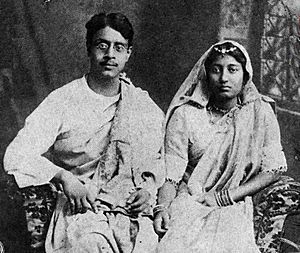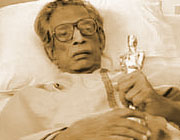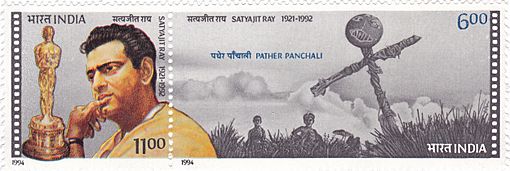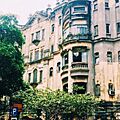Satyajit Ray facts for kids
Quick facts for kids
Satyajit Ray
|
|
|---|---|
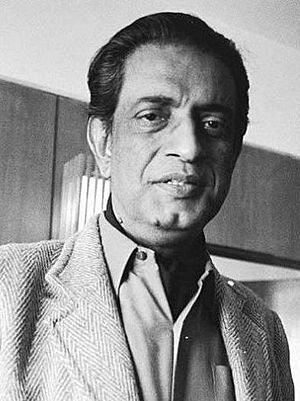
Ray in New York, 1981
|
|
| Born | 2 May 1921 |
| Died | 23 April 1992 (aged 70) Calcutta, West Bengal, India
|
| Alma mater | Presidency College (BA) Visva-Bharati University (MA) |
| Occupation |
|
| Years active | 1950–1992 |
|
Works
|
Full list |
| Spouse(s) |
Bijoya Ray
(m. 1949) |
| Children | Sandip Ray (son) |
| Parents |
|
| Relatives | Upendrakishore Ray Chowdhury (grandfather) Shukhalata Rao (aunt) |
| Awards | Full list |
| Honors |
|
| Signature | |
Satyajit Ray (born May 2, 1921 – died April 23, 1992) was a famous Indian film director, screenwriter, and author. He was also a music composer, illustrator, and calligrapher. Many people think he was one of the greatest filmmakers of all time.
Ray is well-known for movies like The Apu Trilogy (1955–1959), The Music Room (1958), and Charulata (1964). He also created the fun Goopy - Bagha trilogy.
He was born in Calcutta, India. His father, Sukumar Ray, was a famous writer of funny poems. Satyajit Ray started his career as an artist for advertisements. He became interested in making films after meeting French director Jean Renoir. He also saw the Italian film Bicycle Thieves (1948) in London, which inspired him greatly.
Ray made 36 films in total, including full-length movies, documentaries, and short films. His first film, Pather Panchali (1955), won many international awards. This movie, along with Aparajito (1956) and Apur Sansar (1959), makes up The Apu Trilogy. Ray did many jobs for his films, like writing the script, choosing the actors, creating the music, and editing.
He also wrote many short stories and novels, especially for young people. Some of his popular characters include Feluda the detective and Professor Shonku the scientist.
Satyajit Ray received many important awards during his life. These include 36 Indian National Film Awards and an Academy Honorary Award in 1992. In 1992, the Government of India gave him the Bharat Ratna, which is India's highest award for civilians.
Contents
Ray's Early Life and Education
Family Background
Satyajit Ray came from a family with a long history. His family got the name 'Ray' from the Mughals.
His grandfather, Upendrakishore Ray, was born in 1863. He was a writer, artist, and publisher. He even started his own printing press called U. Ray and Sons.
Ray's father, Sukumar Ray, was Upendrakishore's son. Sukumar Ray was a famous writer of nonsense rhymes and children's books in Bengali. His book Abol Tabol is very well-known.
Growing Up and School
Satyajit Ray was born in Calcutta (now Kolkata). His father died when Satyajit was only two years old. Ray grew up in the house where his grandfather's printing press was. He loved watching the machines and how books were made. He was especially interested in Sandesh, a children's magazine his grandfather started.
Ray went to Ballygunge Government High School in Calcutta. He later studied economics at Presidency College, Calcutta. When he was in school, he watched many Hollywood movies. Films by Charlie Chaplin and others made a big impression on him. He also loved Western classical music.
In 1940, his mother wanted him to study at Visva-Bharati University in Santiniketan. This university was started by the famous poet Rabindranath Tagore. Ray wasn't sure about going at first, but his mother convinced him. There, he learned to appreciate Oriental art. He said he learned a lot from famous painters like Nandalal Bose. He even made a documentary film about one of his teachers, Benode Behari Mukherjee, called The Inner Eye.
Ray as an Artist and Designer
In 1943, Ray started working at a British advertising company called D.J. Keymer. He was a junior artist there. He learned a lot about Indian commercial art.
Later, he also worked for Signet Press, a new publishing company. The owner, D. K. Gupta, asked Ray to design book covers and gave him complete artistic freedom. Ray became a leading artist for book covers and typography (the art of arranging type).
Ray designed covers for many books. He also worked on a children's version of a classic Bengali novel called Pather Panchali. He designed the cover and drew pictures for the book. This story greatly influenced him, and he later made it into his first film.
During World War II, Ray became friends with American soldiers in Calcutta. They told him about the latest American films. He also met a British airman who loved films, chess, and classical music, just like Ray.
Ray often went to the Coffee House where many smart people met for casual chats. He became friends with people like Bansi Chandragupta, who later became a famous art director. In 1947, Ray helped start the Calcutta Film Society. They showed many foreign films, which Ray studied closely.
In 1949, Ray married Bijoya Das. They had a son named Sandip Ray, who also became a film director. That same year, French director Jean Renoir came to Calcutta to film The River. Ray helped him find places to film. Ray told Renoir about his idea to film Pather Panchali, and Renoir encouraged him.
In 1950, Ray went to London for six months for his job. While there, he watched 99 films. The movie that changed him the most was Bicycle Thieves (1948) by Vittorio De Sica. Ray later said that after watching it, he decided he wanted to become a filmmaker.
Ray's Film Career
The Apu Trilogy (1950–1959)
Ray was deeply moved by the 1928 novel Pather Panchali, which tells the story of a boy named Apu growing up in a Bengali village. He decided to turn it into his first film. Pather Panchali didn't have a written script. Ray made it from his own drawings and notes.
Ray put together a team of people who didn't have much experience. His cameraman, Subrata Mitra, and art director, Bansi Chandragupta, later became very famous. Most of the actors were not professionals. Ray started filming in late 1952 using his own money. He hoped to get more money later, but it was hard to find producers who wouldn't try to change his vision.
Because of this, Ray filmed Pather Panchali over two and a half years, which is a very long time for a movie. He refused money from people who wanted to change the story or control the film. He also didn't listen to the Indian government's advice to add a happy ending. However, he did get some funding that helped him finish the movie.
Pather Panchali was released in 1955 and was praised by critics. It won many awards and was shown in theaters for a long time in India and other countries. The Times of India newspaper wrote that it was "pure cinema."
Ray's international career really took off after his next film, Aparajito (1956), which was the second part of The Apu Trilogy. This film shows the struggles of a young man, Apu, and his loving mother. Aparajito won the Golden Lion award at the Venice Film Festival, making Ray very famous.
In 1958, Ray made two other films: the comedy Parash Pathar (The Philosopher's Stone) and Jalsaghar (The Music Room). The Music Room is about rich landowners who are losing their wealth.
Ray hadn't planned to make a trilogy at first. But after being asked about it, he liked the idea. He finished the last film of the trilogy, Apur Sansar (The World of Apu), in 1959. In this film, Ray introduced two of his favorite actors, Soumitra Chatterjee and Sharmila Tagore. The movie starts with Apu living in poverty in Calcutta. He gets into an unusual marriage with a girl named Aparna. Their life together is shown as a beautiful picture of married life.
From Devi to Charulata (1959–1964)
During this time, Ray made films about the British Raj period in India. He also made a documentary about Rabindranath Tagore, a comedy film, and his first film based on his own original story. He also made several films that showed Indian women in a very deep way.
After Apur Sansar, Ray made Devi (The Goddess) in 1960. This film looked at old beliefs in Hindu society. Sharmila Tagore played Doyamoyee, a young wife who is seen as a goddess by her father-in-law.
In 1961, the Prime Minister of India, Jawaharlal Nehru, asked Ray to make a film about Rabindranath Tagore. This was for Tagore's 100th birthday. Ray said it was as much work as making three full movies.
In the same year, Ray helped bring back Sandesh, the children's magazine his grandfather had started. Ray had saved money for years to do this. He started drawing pictures for it and writing stories and essays for children. Writing became a steady way for him to earn money.
In 1962, Ray directed Kanchenjungha. This was his first film based on his own story, and it was also his first color film. It tells the story of a rich family spending an afternoon in Darjeeling, a beautiful hill town. They try to arrange a marriage for their youngest daughter.
In 1964, Ray directed Charulata (The Lonely Wife). This was one of Ray's favorite films, and many critics thought it was his best. Based on a short story by Tagore, the film is about a lonely wife named Charu in 19th-century Bengal. She develops feelings for her husband's brother. Ray said this film had the fewest mistakes of all his works. At the 15th Berlin International Film Festival, Charulata won him the Silver Bear for Best Director.
Other films from this time include Mahanagar (The Big City), Teen Kanya (Three Daughters), and Mahapurush (Holy Man). Mahanagar was praised by critics.
In the 1960s, Ray also visited Japan and met the famous filmmaker Akira Kurosawa, whom he admired greatly.
New Directions (1965–1982)
After Charulata, Ray explored different types of films. He made fantasy movies, science fiction, detective stories, and historical dramas. Ray also tried new things, looking at current issues in Indian life.
One important film from this time is Nayak (The Hero), made in 1966. It's about a movie star who meets a young journalist on a train. The film explores the star's inner struggles during their 24-hour journey.
In 1969, Ray directed one of his most successful films, Goopy Gyne Bagha Byne (The Adventures of Goopy and Bagha). This was a musical fantasy based on a children's story written by his grandfather. It's about a singer named Goopy and a drummer named Bagha who get three magical gifts from the King of Ghosts. They use their gifts to stop a war. This was one of his most expensive projects. Ray also wrote the songs and music for the film.
Next, Ray directed Aranyer Din Ratri (1970) (Days and Nights in the Forest). This film follows four young men from the city who go to the forest for a vacation. It's a deep look at the Indian middle class.
After Aranyer Din Ratri, Ray made films about modern Bengali life. He completed what is called the Calcutta trilogy: Pratidwandi (1970), Seemabaddha (1971), and Jana Aranya (1975). These films were made separately but had similar themes. They focused on young men dealing with difficult situations in society. In Pratidwandi (The Adversary), Ray used new filming techniques, like scenes in negative and dream sequences.
Also in the 1970s, Ray turned two of his popular stories into detective films. These were Sonar Kella (The Golden Fortress) and Joi Baba Felunath (The Elephant God). Even though they were for children and young adults, they became very popular with everyone.
In 1977, Ray finished Shatranj Ke Khilari (The Chess Players). This was a film in the Hindustani language, not Bengali. It was set in India before the Indian Rebellion of 1857. The movie showed how the British took over India. It had famous actors like Sanjeev Kumar and Richard Attenborough.
In 1980, Ray made a sequel to Goopy Gyne Bagha Byne called Hirak Rajar Deshe (Kingdom of Diamonds). This film was a bit political. The evil Diamond King in the movie was a hint about India during a difficult time in its history.
When the movie E.T. came out in 1982, some people noticed it was similar to a script Ray had written earlier called The Alien. Ray said that E.T. might have copied his script. However, the director of E.T., Steven Spielberg, said he was in high school when Ray's script was around.
Final Years (1983–1992)
In 1983, while working on Ghare Baire (Home and the World), Ray had a heart attack. This made it very hard for him to work for the rest of his life. Ghare Baire was finished in 1984 with the help of Ray's son, Sandip Ray, who became the camera operator. The film is about the dangers of extreme nationalism.
In 1987, Ray got better enough to direct the 1990 film Shakha Proshakha (Branches of the Tree). It shows an old man who has lived an honest life. He learns that three of his sons are involved in bad things. The movie ends with the father finding comfort only with his fourth son, who is honest but mentally ill.
Ray's last film, Agantuk (The Stranger), was lighter in mood. It's about a long-lost uncle who visits his niece in Calcutta, making her suspicious about his reasons. The film asks big questions about civilization.
Ray loved his work more than anything else. He would work 12 hours a day. He also enjoyed collecting old things, rare records, paintings, and books.
In 1992, Ray's health got worse because of heart problems. He went to the hospital but didn't recover. Twenty-four days before he died, Ray received an Honorary Academy Award through a video call from Audrey Hepburn. He was very sick but gave a speech, calling it the "best achievement of [his] movie-making career." He passed away on April 23, 1992, nine days before his 71st birthday.
Ray's Literary Works
Ray created two very popular characters in Bengali children's literature: Pradosh Chandra Mitter, also known as Feluda, a detective, and Professor Shonku, a scientist. The Feluda stories are told by his teenage cousin, Topshe, who is like Watson to Feluda's Holmes. The science fiction stories about Professor Shonku are presented as a diary found after the scientist disappeared.
Ray also wrote a collection of nonsense verse called Today Bandha Ghorar Dim. This book includes his translation of Lewis Carroll's famous poem "Jabberwocky". He also wrote funny stories about Mullah Nasiruddin in Bengali.
His short stories were published in collections of 12 stories. Ray loved puzzles and wordplay, and this shows in his stories. His short stories also explored spooky and suspenseful themes that he usually avoided in his films. Most of his writings have been translated into English.
Ray wrote an autobiography about his childhood called Jakhan Choto Chilam (1982), which means Childhood Days: A Memoir in English. In 1994, he published his memoir, My Years with Apu, about making The Apu Trilogy.
He also wrote essays about film, which were published in books like Our Films, Their Films (1976) and Bishoy Chalachchitra (1976). His book Bishoy Chalachchitra was translated into English as Speaking of Films in 2006. It explains his ideas about different parts of filmmaking.
Calligraphy and Design
Ray designed four special fonts for the English alphabet: Ray Roman, Ray Bizarre, Daphnis, and Holiday script. He also designed many Bengali fonts for the Sandesh magazine. Ray Roman and Ray Bizarre won an international competition in 1971.
Even after he became a famous filmmaker, many people in Calcutta knew Ray as a great graphic designer. Ray drew pictures for all his books and designed their covers. He also created all the posters and other advertising materials for his films. He designed covers for books by other authors too.
His designs often mixed traditional Indian art with his own unique style. He could draw in many different ways, which you can see in his book covers, magazine illustrations, posters, and advertisements.
Filmmaking Style and Influences
Ray was greatly influenced by Jean Renoir throughout his career. He also admired Vittorio De Sica, who taught him how to put many details into one shot and use actors who weren't professionals. Ray learned about filmmaking from old Hollywood directors like John Ford and Billy Wilder. He had great respect for his fellow directors Akira Kurosawa and Ingmar Bergman. He also learned techniques like freeze frames from François Truffaut and jump cuts from Jean-Luc Godard.
Ray believed that writing the script was a very important part of directing a film. At first, he only wanted to make films in Bengali. For his two films in other languages, he wrote the script in English, and then translators helped turn it into Hindustani under his guidance.
Ray's art director, Bansi Chandragupta, was also very good at noticing details. Chandragupta's work was so important that Ray would always write his scripts in English first so Chandragupta could read them. Subrata Mitra's camera work in Ray's films was also highly praised.
Ray's film editor was Dulal Datta, but Ray usually told him exactly how to edit the film. Because of money and Ray's careful planning, most of his films (except Pather Panchali) were edited while they were being filmed.
Early in his career, Ray worked with Indian classical musicians. But he found that their main loyalty was to their music, not to his film. So, he learned more about Western classical music, which he wanted to use for his films set in cities. Starting with Teen Kanya, Ray began to compose his own music for his films. Beethoven was Ray's favorite composer.
Ray chose actors from many different backgrounds, from famous stars to people who had never seen a movie. Critics have praised him for being great at directing children, noting wonderful performances in films like Pather Panchali and Sonar Kella. Ray would change how he directed actors depending on their skill.
Actors who worked with Ray trusted him. Ray believed that real life was the best inspiration for films. He said, "No amount of technical polish can make up for artificiality of the theme and the dishonesty of treatment."
What People Thought of Ray's Work
Ray's films are often described as being full of humanism and being understood by people everywhere. They seem simple but have deep meanings. The Japanese director Akira Kurosawa said, "Not to have seen the cinema of Ray means existing in the world without seeing the sun or the moon."
However, some people found his films very slow. Some critics also thought his work wasn't "modern" enough and didn't try new things like other directors of his time. Ray said he couldn't do anything about the slow pace. Kurosawa defended him, saying Ray's films flowed calmly, "like a big river."
Critics have often compared Ray to famous artists like Anton Chekhov and Mozart. The writer V. S. Naipaul compared a scene in Shatranj Ki Khiladi (The Chess Players) to a play by Shakespeare. Even critics who didn't like the style of Ray's films usually agreed that he could show a whole culture with all its small details.
Many famous directors have praised Ray's work. Martin Scorsese said Ray's work is as good as that of other great directors like Ingmar Bergman and Akira Kurosawa. Francis Ford Coppola said Ray was a big influence on him. He especially liked Ray's 1960 film Devi. On a trip to India, Christopher Nolan said he had recently watched Pather Panchali and thought it was "one of the best films ever made."
Sometimes, politics and personal feelings affected how people viewed Ray's work. Some people who supported socialism said Ray didn't care enough about poor people. They also criticized him for making poverty look beautiful in films like Pather Panchali. They said he didn't offer solutions to problems in his stories.
In the early 1980s, an Indian politician named Nargis Dutt criticized Ray. She said he was "exporting poverty" and wanted him to make films that showed "Modern India."
Ray's Legacy
Ray is a very important cultural figure in India and for Bengali people around the world. When he died, the city of Calcutta almost stopped as thousands of people gathered to pay their respects. Ray has had a huge influence on Bengali cinema. Many Bengali directors, like Aparna Sen and Rituparno Ghosh, have been influenced by him. Beyond India, famous filmmakers like Martin Scorsese, Francis Ford Coppola, George Lucas, Quentin Tarantino, and Christopher Nolan have been influenced by Ray's style.
Many books also mention Ray or his work. For example, Salman Rushdie's book Haroun and the Sea of Stories has fish characters named Goopy and Bagha, which is a tribute to Ray's fantasy film.
In 1993, the University of California, Santa Cruz started the Satyajit Ray Film and Study collection. In 1995, the Government of India created the Satyajit Ray Film and Television Institute for film studies. At the London Film Festival, there is a "Satyajit Ray Award" given to new directors whose films show the "artistry, compassion and humanity of Ray's vision."
Many documentary films have been made about Ray in India. In 2016, Satyajit's son, Sandip, filmed his father's famous library for a movie.
On February 23, 2021, for Satyajit Ray's 100th birthday, the Indian government announced a new award in his name. This award will be as important as the Dadasaheb Phalke Award.
Preserving Ray's Films
The Academy Film Archive has saved and preserved many of Ray's films. This helps make sure that his important works can be seen and studied by people for many years to come.
International Film Festival of India
The International Film Festival of India honored Satyajit Ray on his 100th birthday in 2021. They showed a special collection of his films. Also, the festival's annual Lifetime Achievement award was renamed the 'Satyajit Ray Lifetime Achievement Award' to honor his great work.
Awards and Recognition
Ray received many awards, including 36 National Film Awards from the Government of India. He also won awards at international film festivals. At the Berlin International Film Festival, he won the Silver Bear for Best Director more than once. He also holds the record for the most nominations for the Golden Bear award, with seven.
At the Venice Film Festival, where he had won a Golden Lion for Aparajito (1956), he received the Golden Lion Honorary Award in 1982. That same year, he received an honorary award at the 1982 Cannes Film Festival. Ray was the second film person, after Charlie Chaplin, to receive an honorary doctorate degree from Oxford University.
He was given the Dadasaheb Phalke Award in 1985 and the Legion of Honour by the President of France in 1987. The Government of India gave him the Padma Bhushan in 1965 and the highest civilian honor, Bharat Ratna, just before he passed away. The Academy of Motion Picture Arts and Sciences gave Ray an Honorary Award in 1992 for his lifetime achievements. In 1992, he also received the Akira Kurosawa Award for Lifetime Achievement in Directing after his death.
In a 2004 BBC poll, people voted him No. 13 on the "Greatest Bengali of all time" list. In 1992, Sight & Sound magazine ranked Ray at No. 7 in its list of "Top 10 Directors" of all time, making him the highest-ranking Asian filmmaker on that list. In 2007, Total Film magazine included Ray in its "100 Greatest Film Directors Ever" list.
Ray Family
| Upendra Kishore Ray | Bidhumukhi Devi | ||||||||||||||||||||||||||||||||||||||||||||||||||||||||||||||||||
| Sukumar Ray | Suprabha Ray | Sukhalata Ray | Subinoy Ray | Subimal Ray | Punyalata Chakrabarti | Shantilata | |||||||||||||||||||||||||||||||||||||||||||||||||||||||||||||
| Satyajit Ray | Bijoya Ray | ||||||||||||||||||||||||||||||||||||||||||||||||||||||||||||||||||
| Sandip Ray | Lalita Ray | ||||||||||||||||||||||||||||||||||||||||||||||||||||||||||||||||||
| Souradip Ray | |||||||||||||||||||||||||||||||||||||||||||||||||||||||||||||||||||
Filmography
Images for kids
See also
 In Spanish: Satyajit Ray para niños
In Spanish: Satyajit Ray para niños
- Culture of Bengal
- Culture of West Bengal
- List of Bengali-language authors (chronological)
- Literary works of Satyajit Ray
- Parallel cinema
- List of Indian writers


